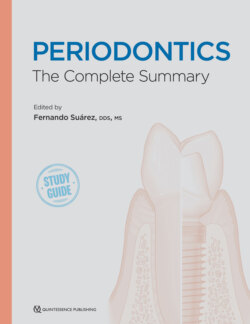Читать книгу Periodontics - Fernando Suarez - Страница 90
На сайте Литреса книга снята с продажи.
ENAMEL PEARLS
ОглавлениеAn enamel pearl is defined as a focal mass of enamel that has formed apical to the CEJ and is typically located in the area between the roots of molars.1 Historically, enamel pearls have also been referred to as droplets, nodules, globules, knots, and exostoses, based on their surface morphology.46,56 Interestingly, some authors referred to them as enamelomas as an early inaccurate delineation of an odontogenic tumor.57,58 These enamel anomalies are described as spheroid masses with a mean diameter of 0.96 mm and a prevalence of 4.6%. They are generally located at the coronal third of the root with a mean distance of 2.8 mm from the CEJ.59 Moskow and Canut performed a literature review and reported an incidence rate ranging from 1.1% to 9.7% (mean: 2.69%) and a predilection for maxillary third and second molars.60 Furthermore, Cavanha introduced a classification based on macroscopic and microscopic observations based on the number, location, and composition of the enamel pearls (Table 5-3).61
TABLE 5-3 Classification of enamel pearls61
| Enamel pearls | Extradental | Solitary | Enamel nodules in periodontiumEnamel-cementum nodules in periodontium |
| Adherent | True enamel pearlEnamel-dentine pearlEnamel-dentine-pulp pearl | ||
| Intradental | CoronalCervicalRadicular |
The formation of extradental enamel pearls is attributed to activity of the Hertwig epithelial root sheath (HERS) that failed to detach from the dental surface after root formation.62 Interestingly, Slavkin et al developed a model to explore the HERS differentiation as well as root, cementum, and bone formation.63 They noted deposits that resembled enamel pearls during the differentiation, disintegration, and detachment of the HERS. Conversely, others speculated that enamel pearl formation occurs at the early stages of tooth development because they have been associated with dentin and pulp.64 In fact, this theory could explain the formation of intradental enamel pearls resulting from focal ameloblastic activity of invaginated cells or entrapped enamel epithelium from the cervical loop during root formation within newly forming dentin.65 Nevertheless, the process of formation of enamel pearls at some locations remains to be further elucidated.60
